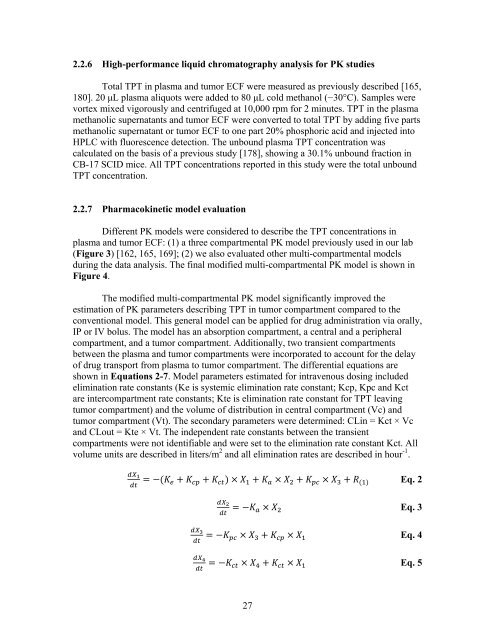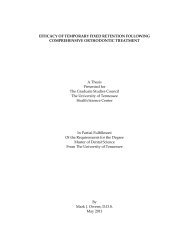BEVACIZUMAB EFFECT ON TOPOTECAN PHARMACOKINETICS ...
BEVACIZUMAB EFFECT ON TOPOTECAN PHARMACOKINETICS ...
BEVACIZUMAB EFFECT ON TOPOTECAN PHARMACOKINETICS ...
You also want an ePaper? Increase the reach of your titles
YUMPU automatically turns print PDFs into web optimized ePapers that Google loves.
2.2.6 High-performance liquid chromatography analysis for PK studies<br />
Total TPT in plasma and tumor ECF were measured as previously described [165,<br />
180]. 20 μL plasma aliquots were added to 80 μL cold methanol (−30°C). Samples were<br />
vortex mixed vigorously and centrifuged at 10,000 rpm for 2 minutes. TPT in the plasma<br />
methanolic supernatants and tumor ECF were converted to total TPT by adding five parts<br />
methanolic supernatant or tumor ECF to one part 20% phosphoric acid and injected into<br />
HPLC with fluorescence detection. The unbound plasma TPT concentration was<br />
calculated on the basis of a previous study [178], showing a 30.1% unbound fraction in<br />
CB-17 SCID mice. All TPT concentrations reported in this study were the total unbound<br />
TPT concentration.<br />
2.2.7 Pharmacokinetic model evaluation<br />
Different PK models were considered to describe the TPT concentrations in<br />
plasma and tumor ECF: (1) a three compartmental PK model previously used in our lab<br />
(Figure 3) [162, 165, 169]; (2) we also evaluated other multi-compartmental models<br />
during the data analysis. The final modified multi-compartmental PK model is shown in<br />
Figure 4.<br />
The modified multi-compartmental PK model significantly improved the<br />
estimation of PK parameters describing TPT in tumor compartment compared to the<br />
conventional model. This general model can be applied for drug administration via orally,<br />
IP or IV bolus. The model has an absorption compartment, a central and a peripheral<br />
compartment, and a tumor compartment. Additionally, two transient compartments<br />
between the plasma and tumor compartments were incorporated to account for the delay<br />
of drug transport from plasma to tumor compartment. The differential equations are<br />
shown in Equations 2-7. Model parameters estimated for intravenous dosing included<br />
elimination rate constants (Ke is systemic elimination rate constant; Kcp, Kpc and Kct<br />
are intercompartment rate constants; Kte is elimination rate constant for TPT leaving<br />
tumor compartment) and the volume of distribution in central compartment (Vc) and<br />
tumor compartment (Vt). The secondary parameters were determined: CLin = Kct × Vc<br />
and CLout = Kte × Vt. The independent rate constants between the transient<br />
compartments were not identifiable and were set to the elimination rate constant Kct. All<br />
volume units are described in liters/m 2 and all elimination rates are described in hour -1 .<br />
<br />
Eq. 2<br />
<br />
Eq. 3<br />
<br />
Eq. 4<br />
<br />
Eq. 5<br />
27
















